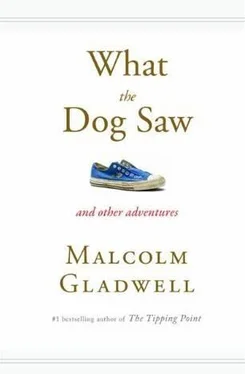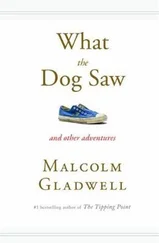Malcolm Gladwell - What the Dog Saw - And Other Adventures
Здесь есть возможность читать онлайн «Malcolm Gladwell - What the Dog Saw - And Other Adventures» весь текст электронной книги совершенно бесплатно (целиком полную версию без сокращений). В некоторых случаях можно слушать аудио, скачать через торрент в формате fb2 и присутствует краткое содержание. Жанр: Психология, на английском языке. Описание произведения, (предисловие) а так же отзывы посетителей доступны на портале библиотеки ЛибКат.
- Название:What the Dog Saw: And Other Adventures
- Автор:
- Жанр:
- Год:неизвестен
- ISBN:нет данных
- Рейтинг книги:5 / 5. Голосов: 1
-
Избранное:Добавить в избранное
- Отзывы:
-
Ваша оценка:
- 100
- 1
- 2
- 3
- 4
- 5
What the Dog Saw: And Other Adventures: краткое содержание, описание и аннотация
Предлагаем к чтению аннотацию, описание, краткое содержание или предисловие (зависит от того, что написал сам автор книги «What the Dog Saw: And Other Adventures»). Если вы не нашли необходимую информацию о книге — напишите в комментариях, мы постараемся отыскать её.
What the Dog Saw: And Other Adventures — читать онлайн бесплатно полную книгу (весь текст) целиком
Ниже представлен текст книги, разбитый по страницам. Система сохранения места последней прочитанной страницы, позволяет с удобством читать онлайн бесплатно книгу «What the Dog Saw: And Other Adventures», без необходимости каждый раз заново искать на чём Вы остановились. Поставьте закладку, и сможете в любой момент перейти на страницу, на которой закончили чтение.
Интервал:
Закладка:
Thirty years ago, the videocassette recorder came on the market, and it was a disruptive product, too: it was supposed to make it possible to tape a television show so that no one would ever again be chained to the prime-time schedule. Yet, as ubiquitous as the VCR became, it was seldom put to that purpose. That’s because the VCR was never pitched: no one ever explained the gadget to American consumers – not once or twice but three or four times – and no one showed them exactly how it worked or how it would fit into their routine, and no pair of hands guided them through every step of the process. All the VCR-makers did was hand over the box with a smile and a pat on the back, tossing in an instruction manual for good measure. Any pitchman could have told you that wasn’t going to do it.
Once, when I was over at Ron’s house in Coldwater Canyon, sitting on one of the high stools in his kitchen, he showed me what real pitching is all about. He was talking about how he had just had dinner with the actor Ron Silver, who was playing Ron’s friend Robert Shapiro in a new movie about the O. J. Simpson trial. “They shave the back of Ron Silver’s head so that he’s got a bald spot, because, you know, Bob Shapiro’s got a bald spot back there, too,” Ron said. “So I say to him, ‘You’ve gotta get GLH.’ ” GLH, one of Ron’s earlier products, is an aerosol spray designed to thicken the hair and cover up bald spots. “I told him, ‘It will make you look good. When you’ve got to do the scene, you shampoo it out.’ ”
At this point, the average salesman would have stopped. The story was an aside, no more. We had been discussing the Showtime Rotisserie, and on the counter behind us was a Showtime cooking a chicken and next to it a Showtime cooking baby-back ribs, and on the table in front of him Ron’s pasta maker was working, and he was frying some garlic so that we could have a little lunch. But now that he had told me about GLH , it was unthinkable that he would not also show me its wonders. He walked quickly over to a table at the other side of the room, talking as he went. “People always ask me, ‘Ron, where did you get that name GLH?’ I made it up. Great-Looking Hair.” He picked up a can. “We make it in nine different colors. This is silver-black.” He picked up a hand mirror and angled it above his head so that he could see his bald spot. “Now, the first thing I’ll do is spray it where I don’t need it.” He shook the can and began spraying the crown of his head, talking all the while. “Then I’ll go to the area itself.” He pointed to his bald spot. “Right here. OK. Now I’ll let that dry. Brushing is fifty percent of the way it’s going to look.” He began brushing vigorously, and suddenly Ron Popeil had what looked like a complete head of hair. “Wow,” I said. Ron glowed. “And you tell me ‘Wow.’ That’s what everyone says. ‘Wow.’ That’s what people say who use it. ‘Wow.’ If you go outside” – he grabbed me by the arm and pulled me out onto the deck – “if you are in bright sunlight or daylight, you cannot tell that I have a big bald spot in the back of my head. It really looks like hair, but it’s not hair. It’s quite a product. It’s incredible. Any shampoo will take it out. You know who would be a great candidate for this? Al Gore. You want to see how it feels?” Ron inclined the back of his head toward me. I had said, “Wow,” and had looked at his hair inside and outside, but the pitchman in Ron Popeil wasn’t satisfied. I had to feel the back of his head. I did. It felt just like real hair.
5.
Ron Popeil inherited more than the pitching tradition of Nathan Morris. He was very much the son of S. J. Popeil, and that fact, too, goes a long way toward explaining the success of the Showtime Rotisserie. S.J. had a ten-room apartment high in the Drake Towers, near the top of Chicago ’s Magnificent Mile. He had a chauffeured Cadillac limousine with a car phone, a rarity in those days, which he delighted in showing off (as in “I’m calling you from the car”). He wore three-piece suits and loved to play the piano. He smoked cigars and scowled a lot and made funny little grunting noises as he talked. He kept his money in T-bills. His philosophy was expressed in a series of epigrams: To his attorney, “If they push you far enough, sue”; to his son, “It’s not how much you spend, it’s how much you make.” And, to a designer who expressed doubts about the utility of one of his greatest hits, the Pocket Fisherman, “It’s not for using; it’s for giving.” In 1974, S.J.’s second wife, Eloise, decided to have him killed, so she hired two hit men – one of whom, aptly, went by the name of Mr. Peeler. At the time, she was living at the Popeil estate in Newport Beach with her two daughters and her boyfriend, a thirty-seven-year-old machinist. When, at Eloise’s trial, S.J. was questioned about the machinist, he replied, “I was kind of happy to have him take her off my hands.” That was vintage S.J. But eleven months later, after Eloise got out of prison, S.J. married her again. That was vintage S.J., too. As a former colleague of his puts it, “He was a strange bird.”
S. J. Popeil was a tinkerer. In the middle of the night, he would wake up and make frantic sketches on a pad he kept on his bedside table. He would disappear into his kitchen for hours and make a huge mess, and come out with a faraway look on his face. He loved standing behind his machinists, peering over their shoulders while they were assembling one of his prototypes. In the late forties and early fifties, he worked almost exclusively in plastic, reinterpreting kitchen basics with a subtle, modernist flair. “Popeil Brothers made these beautiful plastic flour sifters,” Tim Samuelson, a curator at the Chicago Historical Society and a leading authority on the Popeil legacy, says. “They would use contrasting colors, or a combination of opaque plastic with a translucent swirl plastic.” Samuelson became fascinated with all things Popeil after he acquired an original Popeil Brothers doughnut maker, in red-and-white plastic, which he felt “had beautiful lines”; to this day, in the kitchen of his Hyde Park high-rise, he uses the Chop-O-Matic in the preparation of salad ingredients. “There was always a little twist to what he did,” Samuelson goes on. “Take the Popeil automatic egg turner. It looks like a regular spatula, but if you squeeze the handle the blade turns just enough to flip a fried egg.”
Walter Herbst, a designer whose firm worked with Popeil Brothers for many years, says that S.J.’s modus operandi was to “come up with a holistic theme. He’d arrive in the morning with it. It would be something like” – Herbst assumes S.J.’s gruff voice – “ ‘We need a better way to shred cabbage.’ It was a passion, an absolute goddam passion. One morning, he must have been eating grapefruit, because he comes to work and calls me and says, ‘We need a better way to cut grapefruit!’ ” The idea they came up with was a double-bladed paring knife, with the blades separated by a fraction of an inch so that both sides of the grapefruit membrane could be cut simultaneously. “There was a little grocery store a few blocks away,” Herbst says. “So S.J. sends the chauffeur out for grapefruit. How many? Six. Well, over the period of a couple of weeks, six turns to twelve and twelve turns to twenty, until we were cutting thirty to forty grapefruits a day. I don’t know if that little grocery store ever knew what happened.”
S. J. Popeil’s finest invention was undoubtedly the Veg-O-Matic, which came on the market in 1960 and was essentially a food processor, a Cuisinart without the motor. The heart of the gadget was a series of slender, sharp blades strung like guitar strings across two Teflon-coated metal rings, which were made in Woodstock, Illinois, from 364 Alcoa, a special grade of aluminum. When the rings were aligned one on top of the other so that the blades ran parallel, a potato or an onion pushed through would come out in perfect slices. If the top ring was rotated, the blades formed a crosshatch, and a potato or an onion pushed through would come out diced. The rings were housed in a handsome plastic assembly, with a plunger to push the vegetables through the blades. Technically, the Veg-O-Matic was a triumph: the method of creating blades strong enough to withstand the assault of vegetables received a US patent. But from a marketing perspective it posed a problem. S.J.’s products had hitherto been sold by pitchmen armed with a mound of vegetables meant to carry them through a day’s worth of demonstrations. But the Veg-O-Matic was too good. In a single minute, according to the calculations of Popeil Brothers, it could produce 120 egg wedges, 300 cucumber slices, 1,150 potato shoestrings, or 3,000 onion dices. It could go through what used to be a day’s worth of vegetables in a matter of minutes. The pitchman could no longer afford to pitch to just a hundred people at a time; he had to pitch to a hundred thousand. The Veg-O-Matic needed to be sold on television, and one of the very first pitchmen to grasp this fact was Ron Popeil.
Читать дальшеИнтервал:
Закладка:
Похожие книги на «What the Dog Saw: And Other Adventures»
Представляем Вашему вниманию похожие книги на «What the Dog Saw: And Other Adventures» списком для выбора. Мы отобрали схожую по названию и смыслу литературу в надежде предоставить читателям больше вариантов отыскать новые, интересные, ещё непрочитанные произведения.
Обсуждение, отзывы о книге «What the Dog Saw: And Other Adventures» и просто собственные мнения читателей. Оставьте ваши комментарии, напишите, что Вы думаете о произведении, его смысле или главных героях. Укажите что конкретно понравилось, а что нет, и почему Вы так считаете.












